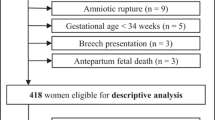Abstract
Purpose
To assess the effects of mechanical dilatation of the cervix during cesarean section on postoperative morbidity.
Methods
A total of 447 women with elective cesarean section were included in the Dondi trial (Dilatation or no dilatation of the cervix during cesarean section). The primary outcome measure of this randomized controlled trial was postpartum hemorrhage (PPH) within 6 weeks. Infectious morbidity (puerperal fever, endometritis, wound infection, and urinary tract infection), blood loss (need for blood transfusion or change in hemoglobin levels), and operating time were also evaluated.
Results
The rate of PPH within 6 weeks was not different between the two groups [dilatation group: 5 (2.4 %), no dilatation group: 3 (1.2 %), p = 0.479]. Infectious morbidity, blood loss, and operating time were not diverse as well. The only significant difference between the two groups was the rate of retained products of conception with fewer cases after cervical dilatation (0 versus 6.2 %, p < 0.001).
Conclusions
Dilatation of the cervix during cesarean section compared with no dilatation of the cervix did not influence the risk of postpartum hemorrhage. However, there were fewer cases with retained products of conception after dilatation.
Similar content being viewed by others
References
Betran AP, Torloni MR, Zhang JJ, Gulmezoglu AM (2015) Section WHOWGoC. WHO Statement on cesarean section rates. BJOG
Allen VM, O’Connell CM, Liston RM, Baskett TF (2003) Maternal morbidity associated with cesarean delivery without labor compared with spontaneous onset of labor at term. Obstet Gynecol 102(3):477–482
Dahlke JD, Mendez-Figueroa H, Rouse DJ, Berghella V, Baxter JK, Chauhan SP (2013) Evidence-based surgery for cesarean delivery: an updated systematic review. Am J Obstet Gynecol 209(4):294–306
Group CC, Abalos E, Addo V, Brocklehurst P, El Sheikh M, Farrell B et al (2013) Cesarean section surgical techniques (CORONIS): a fractional, factorial, unmasked, randomised controlled trial. Lancet 382(9888):234–248
Ahmed B, Abu Nahia F, Abushama M (2005) Routine cervical dilatation during elective cesarean section and its influence on maternal morbidity: a randomized controlled study. J Perinat Med 33(6):510–513
Gungorduk K, Yildirim G, Ark C (2009) Is routine cervical dilatation necessary during elective cesarean section? A randomised controlled trial. Aust N Z J Obstet Gynaecol 49(3):263–267
Tosun M, Sakinci M, Celik H, Torumtay B, Yazici E, Alper T et al (2011) A randomized controlled study investigating the necessity of routine cervical dilatation during elective cesarean section. Arch Gynecol Obstet 284(1):85–89
Liabsuetrakul T, Peeyananjarassri K (2011) Mechanical dilatation of the cervix at non-labour cesarean section for reducing postoperative morbidity. Cochrane Database Syst Rev 11:CD008019
Berlit S, Nickol J, Weiss C, Tuschy B, Mayer J, Sutterlin M et al (2013) Cervical dilatation and curettage in elective cesarean section. A retrospective analysis. Vivo 27(5):661–665
Brocklehurst P, Quigley M, Ayers S, Juszczak E, Anderson E, Bowler U et al. (2010) Cesarean section surgical techniques: a randomised factorial trial (CAESAR). BJOG 117(11):1366–1376
Clark SL, Belfort MA, Dildy GA, Herbst MA, Meyers JA, Hankins GD (2008) Maternal death in the 21st century: causes, prevention, and relationship to cesarean delivery. Am J Obstet Gynecol 199(1):36 e1–15 discussion 91-2 e7-11
Al-Zirqi I, Vangen S, Forsen L, Stray-Pedersen B (2008) Prevalence and risk factors of severe obstetric hemorrhage. BJOG 115(10):1265–1272
Bergholt T, Stenderup JK, Vedsted-Jakobsen A, Helm P, Lenstrup C (2003) Intraoperative surgical complication during cesarean section: an observational study of the incidence and risk factors. Acta Obstet Gynecol Scand 82(3):251–256
Bollapragada SS, Edozien LC (2002) Apparent absence of lochia after elective cesarean section. J Obstet Gynaecol 22(5):558
Koifman A, Harlev A, Sheiner E, Press F, Wiznitzer A (2009) Routine cervical dilatation during elective cesarean delivery—Is it really necessary? J Matern Fetal Neonatal Med 22(7):608–611
Author information
Authors and Affiliations
Corresponding author
Ethics declarations
Funding
There was no funding.
Conflict of interest
There are no conflicts of interest.
Ethical approval
All procedures performed in this study were in accordance with the ethical standards of the institutional and national research committee and with the 1964 Helsinki declaration and its later amendments or comparable ethical standards.
Informed consent
Informed consent was obtained from all individual participants included in the study.
Rights and permissions
About this article
Cite this article
Kirscht, J., Weiss, C., Nickol, J. et al. Dilatation or no dilatation of the cervix during cesarean section (Dondi Trial): a randomized controlled trial. Arch Gynecol Obstet 295, 39–43 (2017). https://doi.org/10.1007/s00404-016-4189-4
Received:
Accepted:
Published:
Issue Date:
DOI: https://doi.org/10.1007/s00404-016-4189-4




